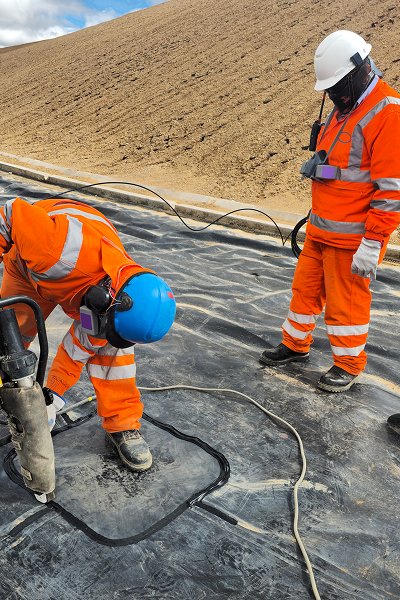Product Definition and Structure
Geomembrane is usually a single-layer anti-seepage film made of high molecular polymers (such as HDPE, LDPE, LLDPE, PVC, EVA, etc.) through blow molding, cast film or calendering. The thickness is usually between 0.2mm and 3.0mm. HDPE (high-density polyethylene) geomembrane is the most widely used.
Its main structural features are as follows:
Homogeneous structure: the whole is composed of a single polymer material;
No fiber support: the membrane itself has no textile or non-woven fabric reinforcement layer;
Smooth or rough surface: can be customized according to different engineering friction requirements;
Uniform thickness, tensile performance and sealing performance are concentrated in the membrane body.

Composite geomembrane structure
Composite geomembrane is a composite anti-seepage material that combines geomembrane and geotextile (generally short-filament needle-punched non-woven fabric or long-filament non-woven fabric) through hot pressing, hot melting, coating or laminating. Common structures include:
One cloth and one membrane (cloth membrane)
Two cloths and one membrane (cloth membrane cloth)
Membrane cloth membrane structure (for reinforced composite membranes with specific requirements)

Applicable scenario analysis
Landfill anti-seepage
Recommended products: HDPE ordinary geomembrane + composite geomembrane combination
Reason analysis:
HDPE geomembrane provides core anti-seepage function and has excellent anti-chemical corrosion and anti-aging capabilities.
Composite geomembrane can be used as a protective layer or auxiliary layer to enhance the overall strength of the system and prevent puncture by sharp objects.
Water conservancy projects (reservoirs, dams, channels)
Recommended products: composite geomembrane
Reason analysis:
Water conservancy projects are mostly surface construction, which is easily affected by water pressure and soil settlement.
The geotextile in the composite membrane improves tensile and puncture resistance, and is suitable for areas with uneven settlement.
It has good flexibility and is easy to construct on slopes and large water surfaces.
Subway, tunnel, underground space structure anti-seepage
Recommended product: composite geomembrane (two cloths and one membrane structure)
Cause analysis:
The structure is complex and bears pressure for a long time; the composite membrane has strong puncture resistance and is more suitable for irregular foundations.
It provides dual functions of anti-seepage and support to prevent groundwater infiltration or structural leakage.


| Project Type | Recommended Material | Selection Basis |
|---|---|---|
| High-performance lining | HDPE Geomembrane | Excellent chemical resistance and impermeability |
| Uneven settlement areas | Composite Geomembrane | Better flexibility and puncture resistance |
| Landscaping or aquaculture | LLDPE or Composite Membrane | Flexible, easy to install, and cost-effective |
| Chemical exposure risk | HDPE Geomembrane | Outstanding chemical stability and durability |
| Anti-seepage + filtration | Composite Geomembrane | Multi-functional, combines drainage and protection layers |
Recommended Thickness Guidelines
| Application Area | Suggested Thickness | Notes |
|---|---|---|
| Landfill liner | HDPE 1.5 mm – 2.0 mm | For reliable, long-term containment |
| Artificial lakes | Composite 300 g/m² – 600 g/m² | Medium weight, easy to deploy |
| Chemical ponds | HDPE ≥ 2.0 mm | High resistance to corrosion |
| Agricultural channels | LLDPE or composite ≥ 0.8 mm | Flexible, cost-effective |
Frequently Asked Questions (FAQ)
1. Q: Which is more durable, composite geomembrane or ordinary geomembrane?
A: Generally speaking, HDPE ordinary geomembrane is more resistant to chemical corrosion and aging, with a lifespan of more than 50 years, and is more suitable for long-term anti-seepage projects. Although composite geomembrane has better flexibility, it is slightly less resistant to aging, and its lifespan is generally 20-30 years, depending on the project environment and maintenance conditions.
2. Q: Is composite geomembrane a "geotextile + geomembrane" structure?
A: Yes. Composite geomembrane is a multifunctional material that combines geotextile (needle punched or woven) with PE geomembrane (HDPE, LDPE or LLDPE) by hot pressing, calendering or gluing, and usually has multiple functions of "anti-seepage + anti-filtration + protection".
3. Q: Can composite geomembrane be welded? What is the welding strength?
A: Composite geomembrane can be welded, but because the surface contains a cloth layer, hot air welding or extrusion welding is often used, and the welding strength is slightly lower than that of pure HDPE membrane. If the anti-seepage requirements are high, it is recommended to overlap the membrane layer and test the welds at the same time (such as air pressure test or vacuum test).
4. Q: What basic treatments are required when laying geomembranes?
A: The foundation surface needs to be flat and free of sharp objects, the compaction degree should meet the design requirements, and the slope edge should have a smooth transition. To avoid the risk of puncture, a layer of protective geotextile is generally laid under the geomembrane, and some projects also add a protective layer or isolation layer above the membrane.
5. Q: What is the difference between "1 cloth 1 membrane" and "2 cloth 1 membrane" of composite geomembrane?
A:
"1 cloth 1 membrane": light structure, soft, suitable for slope or manual construction;
"2 cloth 1 membrane": geotextiles are on the top and bottom, the membrane body is better protected and has higher strength, suitable for projects with high protection requirements such as landfills and reservoirs.
6. Q: Can HDPE geomembrane be used directly exposed?
A: Although HDPE film has a certain ability to resist UV rays, long-term exposure to strong light, hot wind, rain and snow will still accelerate aging. To extend the service life, it is recommended to cover it with soil or protective layer for shielding, especially in landfills, tunnels and other projects.


